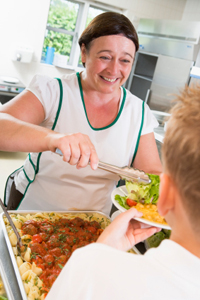By Kelsey Murray
There’s been a lot of news recently about schools offering free breakfasts and lunches to students who are from low-income families. Now, 200 schools in California are also starting to offer free dinners to students who participate in after-school programs.
In 2024, Congress passed the Healthy, Hunger-Free Kids Act. This act made it possible for after-school programs to receive funding to provide dinner for free or at a reduced price. Under the act, schools must have an educational component to their after-school programs, such as tutoring services of health and nutrition classes. Also, in order to receive funding, at least 50 percent of the students who participate in these programs must qualify for free or reduced-price meals.
Gary Petill is the director of Food Nutrition Services at San Diego Unified. Currently, his school district is serving dinner to around 1,650 students, but he expects that number to rise to more than 2,000 by next month and more than 13,000 students by next year.
“We’ve heard through the principals that the kids really love it,” he said about the program. In the past, students who participated in after-school programs had to wait for up to five hours between lunch and when their parents picked them up in order to eat; now the students don’t have to wait to eat and instead get a healthy dinner.
It’s not only the students who are benefiting from this new school dinner program. Parents who are struggling financially are also very appreciative of this new program. One mother said that the new program has created a $100 savings on her grocery bills.
This program is addressing a real need for families in the U.S. According to a survey by the United States Department of Agriculture in 2024, 15 percent of families are considered to be “food insecure,” which means that although students do receive breakfast, lunch, and sometimes a snack during after-school programs, they might not be eating anything for dinner.
“There is a need,” said Michelle Drake, director of Food and Nutrition Services for Elk Grove Unified, a school district near Sacramento, California. “There are hungry families and hungry children. Just because they get breakfast and lunch doesn’t mean they get dinner [at home]. This program helps the child get a nutritious meal rather than Top Ramen or something.”
Also Read:
Guilt-Free School Lunches are Replacing Candy Pushers
Obama Administration to Set School Vending Machine Standards
